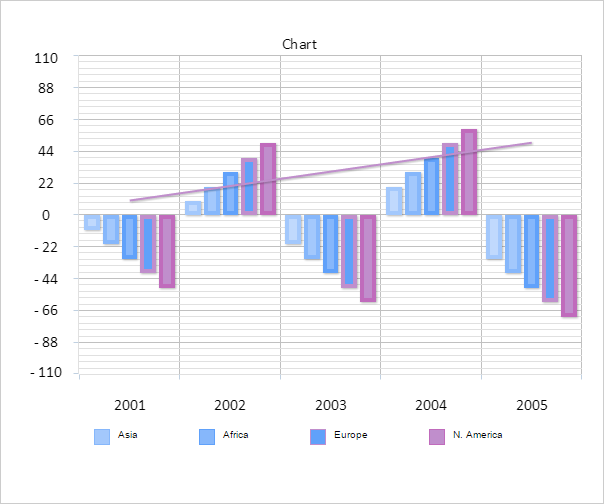
Before executing the example, study the recommendations for code writing.
To create a histogram with legend, use HTML code:
<!DOCTYPE html PUBLIC "-//W3C//DTD XHTML 1.0 Transitional//EN" "http://www.w3.org/TR/xhtml1/DTD/xhtml1-transitional.dtd">
<html>
<head>
<meta http-equiv="X-UA-Compatible" content="IE=edge" />
<meta http-equiv="Content-Type" content="text/html; charset=UTF-8">
<title>Histogram</title>
<script src="../build/PP.js" type="text/javascript"></script>
<script src="../build/PP.GraphicsBase.js" type="text/javascript"></script>
<script src="../build/PP.Charts.js" type="text/javascript"></script>
<script src="../build/PP.Charts_Canvas.js" type="text/javascript"></script>
<link href="../build/PP.css" rel="stylesheet" type="text/css" />
<script src="../resources/PP.resources.ru.js" type="text/javascript"></script>
<style type="text/css">
div#chart {
border: #CCCCCC 1px solid;
padding: 1px;
margin: 1px;
width: 600px;
height: 500px;
}
</style>
<script type="text/javascript">
var chart; // Chart
// Create a chart
function createChart() {
// Create values arrays for data series
var data0 = [-10, 10, -20, 20, -30];
var data1 = [-20, 20, -30, 30, -40];
var data2 = [-30, 30, -40, 40, -50];
var data3 = [-40, 40, -50, 50, -60];
var data4 = [-50, 50, -60, 60, -70];
var trendData = [10, 20, 30, 40, 50];
// Create a color values array
var colors = ["rgb(192,217,253)", "rgb(163,200,252)", "rgb(134,183,251)",
"rgb(96,161,250)", "rgb(192,142,204)", "rgb(192,107,188)"
];
// Chart
chart = new PP.Ui.Chart({
Width: 600, // Chart width
Height: 500, // Chart height
// Chart paddings
PaddingLeft: 15,
PaddingRight: 20,
PaddingTop: 30,
PaddingBottom: 40,
UseSoftPadding: false, // Indicates whether alternative paddings calculation is used
ParentNode: "chart", // Parent element
Type: "Column", // Chart type
ToolTip:{},
AlternateColumnPadding: true,
PointPadding: -0.2,
ExcludeInvisibleSeries: true, // Indicates whether invisible series must be excluded from calculation
// Data series
"Series": [{ // Series 1
"Name": "Australia", // Series name
"Data": data0, // Values array
"Color": colors[0], // Color
"LineColor": colors[1], // Line color
"LineWidth": 4, // Line width
"ShowInLegend": false, // Indicates whether a series is displayed in legend
"IsVisible": true // Indicates whether a series is visible
}, { // Series 2
"Name": "Asia",
"Data": data1,
"Color": colors[1],
"LineColor": colors[2],
"LineWidth": 4,
"ShowInLegend": true
}, { // Series 3
"Name": "Africa",
"Data": data2,
"Color": colors[2],
"LineColor": colors[3],
"LineWidth": 4,
"ShowInLegend": true
}, { // Series 4
"Name": "Europe",
"Data": data3,
"Color": colors[3],
"LineColor": colors[4],
"LineWidth": 4,
"ShowInLegend": true
}, { // Series 5
"Name": "North America",
"Data": data4,
"Color": colors[4],
"LineColor": colors[5],
"LineWidth": 4,
"ShowInLegend": true
}, {
// Trend line
"Type": "Line", // Series type
"Name": "Trend",
"Data": trendData,
"Color": colors[4],
"LineColor": colors[5],
"LineWidth": 2,
"ShowInLegend": false,
"Trend": true
}],
// Category axis
"XAxis": {
"Categories": ["2001", "2002", "2003", "2004", "2005"], // Categories arrays
// Label settings
"Labels": {
"Enabled": true
}
},
// Value axis
"YAxis": {
"Labels": {
"Enabled": true
}, // Label settings
"Max": 110, // Maximum value
"Min": -110, // Minimum value
},
// Secondary value axis
"YSAxis": {
"Enabled": false // Indicates whether axis is active
},
// Chart render area
"PlotArea": {},
// Chart legend
"Legend": {
CellSpacing: 60 // Legend element spacings
},
// Chart title
"Title": {
"Text": "Chart"
}
})
}
</script>
</head>
<body onload="createChart()">
<div id="chart"></div>
</body>
</html>
After executing the example, the Chart component will be placed on html page as histogram with legend:

See also: